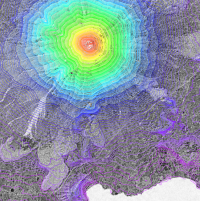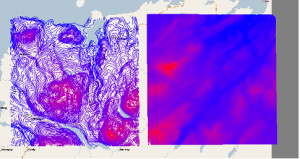Difference between revisions of "Shuttle Radar Topography Mission"
| Line 23: | Line 23: | ||
The difference between various versions is primarily that more error checking and validation is applied at later versions. | The difference between various versions is primarily that more error checking and validation is applied at later versions. | ||
| − | An alternative SRTM dataset with a higher spatial resolution of 1 arc second (about 30 m) is also available | + | An alternative SRTM dataset with a higher spatial resolution of 1 arc second (about 30 m) is also available. As of September 2015 this data set been fully released having similar coverage as the 3 arc-second data set. The 1 arc second data set is available in windPRO 3.0 and later. |
| − | |||
| − | |||
== External Links == | == External Links == | ||
Revision as of 09:01, 22 September 2015
Introduction
The Shuttle Radar Topography Mission (SRTM) data originate from an 11-day mission flown by the space shuttle Endeavour back in February 2000, on its STS-99 mission. The raw data were collected using an instrument named “Spaceborne Imaging Radar-C”. The raw data were later processed and released as usable digital grid files.
Availability from within WindPRO
The data are available directly from within WindPRO. The data can be accessed from the online-services in the following objects:
- Line Object (with purpose to height contour lines)
- Elevation Grid Object
In addition to loading the data directly from the EMD online services, WindPRO also supports importing the original *.hgt files that can also be downloaded from other internet sources.
Data Type
The SRTM data are delivered as gridded data with a spatial resolution of the dataset corresponding to 1 arc second and 3 arc seconds, i.e. approximately 30 m and 90 m distance between grid points. As a part of the processing of the SRTM data from our EMD server, the user has an option of choosing whether the data downloaded should be received as either raw gridded data or converted to height contour lines. In order to use the data for energy yield calculations, the data must be converted to contours.
The original SRTM data are stored as tiles sized 1 degree x 1 degree.
Coverage
About 80% of the total landmass of the Earth is mapped by the STRM data, covering all land between 56 degrees south and 60 degrees northern latitude. A view of the data coverage is shown in the figure below.
Versions and Data Sources
Different versions of the SRTM data exist; at EMD we currently distribute the STRM data version 3 in a 3 arc-second resolution (90 m grid resolution).
The difference between various versions is primarily that more error checking and validation is applied at later versions.
An alternative SRTM dataset with a higher spatial resolution of 1 arc second (about 30 m) is also available. As of September 2015 this data set been fully released having similar coverage as the 3 arc-second data set. The 1 arc second data set is available in windPRO 3.0 and later.
External Links
- Original data are available from the NASA website at http://www2.jpl.nasa.gov/srtm.
- More information on SRTM is available at wikipedia at http://en.wikipedia.org/wiki/Shuttle_Radar_Topography_Mission
- Direct download of 1° x 1° hgt.zip files at http://dds.cr.usgs.gov/srtm/version2_1/SRTM3/
- Direct download of 1° x 1° 1-arc second files at http://earthexplorer.usgs.gov
Acknowledgement
NASA, team around STS-99 and the US public are thanked for making this great digital elevation dataset available in the public domain and thus for aiding the development of renewable energy.



